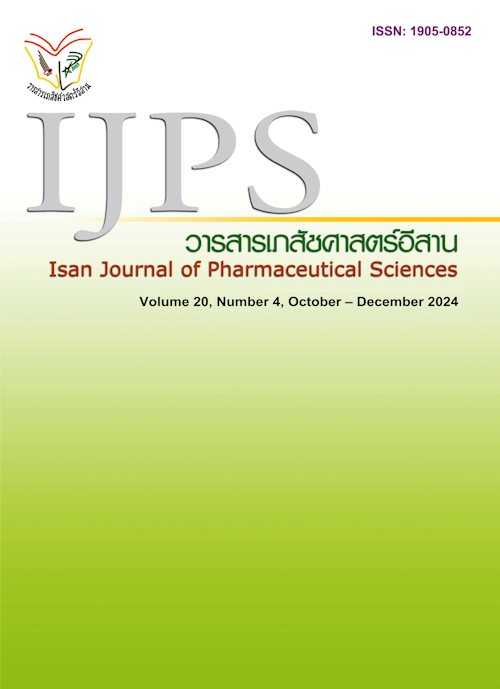ประสิทธิผลและความปลอดภัยในผู้ป่วยที่ได้รับแวนโคมัยซินทางหลอดเลือดดำแบบต่อเนื่องในผู้ป่วยสภาวะไม่วิกฤต
Main Article Content
บทคัดย่อ
แวนโคมัยซินเป็นยาปฏิชีวนะที่ใช้อย่างแพร่หลายในการรักษาภาวะติดเชื้อแบคทีเรียแกรมบวก ปัจจุบันได้มีคำแนะนำการใช้ยาแบบหยดยาต่อเนื่องในผู้ป่วยวิกฤต แต่ยังไม่มีคำแนะนำชัดเจนในผู้ป่วยที่ไม่มีสภาวะวิกฤต วัตถุประสงค์: เพื่อศึกษารูปแบบของการใช้แวนโคมัยซินแบบหยดเข้าหลอดเลือดดำอย่างต่อเนื่อง และติดตามผลลัพธ์ทางคลินิกของผู้ป่วยโรคติดเชื้อที่ไม่มีสภาวะวิกฤต วิธีดำเนินการวิจัย: การศึกษาเชิงพรรณนาแบบเก็บข้อมูลย้อนหลัง ในผู้ป่วยโรคติดเชื้อที่ไม่มีสภาวะวิกฤตและได้รับแวนโคมัยซินแบบหยดยาต่อเนื่องทางหลอดเลือดดำ ในโรงพยาบาลศรีนครินทร์ ระหว่างวันที่ 1 มกราคม พ.ศ. 2553 ถึงวันที่ 31 ตุลาคม พ.ศ. 2566 วิเคราะห์ผลลัพธ์ทางคลินิกในด้านประสิทธิผลการรักษา จากสัดส่วนผู้ป่วยที่ประสบความสำเร็จทั้งในช่วงแรกและเมื่อสิ้นสุดการรักษา การมีระดับยาอยู่ในช่วงเป้าหมาย การเสียชีวิตภายใน 30 วันหลังจากหยุดใช้ยา และการเกิดอาการไม่พึงประสงค์ต่อไตจากการใช้ยา วิเคราะห์ความสัมพันธ์ระหว่างขนาดยาแวนโคมัยซินกับระดับยาเฉลี่ยในเลือดโดยใช้สถิติสหสัมพันธ์ Pearson correlation ผลการวิจัย: พบผู้ป่วยที่ได้รับแวนโคมัยซินแบบหยดยาต่อเนื่องทางหลอดเลือดดำ จำนวน 15 ราย ส่วนใหญ่มีการติดเชื้อในกระแสเลือด (ร้อยละ 33) และระบบประสาทส่วนกลาง (ร้อยละ 20) ผู้ป่วยที่มีระดับยาอยู่ในช่วงเป้าหมายการรักษาได้รับขนาดยาเฉลี่ย 55.5 ± 3.1 มก./กก./วัน จำนวน 3 ราย (ร้อยละ 20) มีผู้ป่วยที่ผลลัพธ์การรักษาดีขึ้นในช่วงแรกจำนวน 9 ราย (ร้อยละ 60) และเมื่อสิ้นสุดการรักษาจำนวน 11 ราย (ร้อยละ 73) ทั้งนี้ไม่มีผู้ป่วยที่เสียชีวิตภายใน 30 วันหลังจากหยุดใช้ยา และไม่มีผู้ป่วยที่เกิดพิษต่อไตจากการใช้ยา โดยขนาดยาแวนโคมัยซินมีความสัมพันธ์เชิงบวกกับระดับยาเฉลี่ยในเลือดในระดับปานกลางอย่างมีนัยสำคัญทางสถิติ (r2 = 0.523, p-value < 0.05) สรุปผลการวิจัย: การใช้แวนโคมัยซินแบบหยดยาต่อเนื่องทางหลอดเลือดดำมีผลลัพธ์การรักษาที่ดี และไม่ก่อให้เกิดพิษต่อไต
Article Details

This work is licensed under a Creative Commons Attribution-NonCommercial-NoDerivatives 4.0 International License.
กรณีที่ใช้บางส่วนจากผลงานของผู้อื่น ผู้นิพนธ์ต้อง ยืนยันว่าได้รับการอนุญาต (permission) ให้ใช้ผลงานบางส่วนจากผู้นิพนธ์ต้นฉบับ (Original author) เรียบร้อยแล้ว และต้องแนบเอกสารหลักฐาน ว่าได้รับการอนุญาต (permission) ประกอบมาด้วย
References
Bland CM and Sutton S. Estimating renal function. Sutton S, editor. McGraw Hill’s NAPLEX® Review Guide [Online]. 2020. [cited 2024 Oct 26]. Available from:https://accesspharmacy.mhmedical.com/content.aspx?bookid=3025§ionid=254093345
Buckman SA, Turnbull IR, Mazuski JE. Empiric antibiotics for sepsis. Surg Infect (Larchmt). 2018; 19(2): 147-154.
Clinical pharmacokinetic equations and calculations. In: Bauer LA. eds. Applied clinical pharmacokinetics, 3e. McGraw-Hill Medical [Online]. 2015. [cited 2024 Oct 26]. Available from: https://accesspharmacy.mhmedical.com/content.aspx?bookid=1374§ionid=74719519
Dubée V, Zeller V, Lhotellier L, Kitzis MD, Ziza JM, Mamoudy P, et al. Continuous high-dose vancomycin combination therapy for methicillin-resistant staphylococcal prosthetic hip infection: a prospective cohort study. Clin Microbiol Infect. 2013; 19(2): E98-105.
Hirai K, Ishii H, Shimoshikiryo T, Shimomura T, Tsuji D, Inoue K, et al. Augmented renal clearance in patients with febrile neutropenia is associated with increased risk for subtherapeutic concentrations of vancomycin. Ther Drug Monit. 2016; 38(6): 706-710.
Ingram PR, Lye DC, Fisher DA, Goh WP, Tam VH. Nephrotoxicity of continuous versus intermittent infusion of vancomycin in outpatient parenteral antimicrobial therapy. Int J Antimicrob Agents. 2009; 34(6): 570-574.
Ingram PR, Lye DC, Tambyah PA, Goh WP, Tam VH, Fisher DA. Risk factors for nephrotoxicity associated with continuous vancomycin infusion in outpatient parenteral antibiotic therapy. J Antimicrob Chemother. 2008; 62(1): 168-171.
Levine JF. Vancomycin: a review. Med Clin North Am. 1987; 71(6): 1135-1145.
Rybak MJ, The pharmacokinetic and pharmacodynamic properties of vancomycin. Clin Infect Dis. 2006; 42: S35-39.
Rybak MJ, Le J, Lodise TP, Levine DP, Bradley JS, Liu C, et al. Therapeutic monitoring of vancomycin for serious methicillin-resistant Staphylococcus aureus infections: A revised consensus guideline and review by the American Society of Health-System Pharmacists, the Infectious Diseases Society of America, the Pediatric Infectious Diseases Society, and the Society of Infectious Diseases Pharmacists. AJHP 2020; 77(11): 835-864.
Sahraei Z, Saffaei A, Alavi DI, Salamzadeh J, Shabani M, Shokouhi S, et al. Evaluation of vancomycin pharmacokinetics in patients with augmented renal clearances: A randomized clinical trial. Front Pharmacol. 2022; 11(13): 1041152.
Shakeraneh P, Fazili T, Wang D, Gilotra T, Steele JM, Seabury RW, et al. Nephrotoxicity risk and clinical effectiveness of continuous versus intermittent Infusion vancomycin among patients in an outpatient parenteral antimicrobial therapy program. Pharmacotherapy. 2020; 40(4): 357-362.
Tafelski S, Nachtigall I, Troeger U, Deja M, Krannich A, Günzel K, et al. Observational clinical study on the effects of different dosing regimens on vancomycin target levels in critically ill patients: Continuous versus intermittent application. J Infect Public Health. 2015; 8(4): 355-363.
Verrall AJ, Llorin R, Tam VH, Lye DC, Sulaiman Z, Zhong L, et al. Efficacy of continuous infusion of vancomycin for the outpatient treatment of methicillin-resistant Staphylococcus aureus infections. J Antimicrob Chemother. 2012; 67(12): 2970-2973.
Wysocki M, Delatour F, Faurisson F, Rauss A, Pean Y, Misset B, et al. Continuous versus intermittent infusion of vancomycin in severe Staphylococcal infections: prospective multicenter randomized study. Antimicrob Agents Chemother. 2001; 45(9): 2460-2467.

